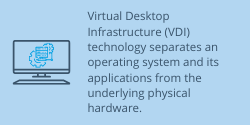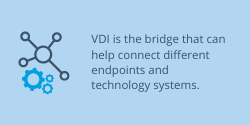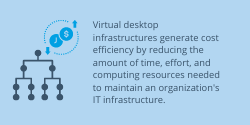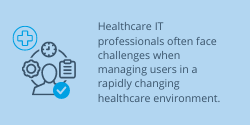
28 Jul Can a Virtual Desktop Solution Improve Patient Care?
Healthcare Insights: Can a Virtual Desktop Solution Improve Patient Care?
There are many reasons why healthcare organizations should consider transitioning to a virtual desktop (VDI) solution. A VDI environment is optimized for patient confidentiality. Access can be clearly defined and policies implemented that only permit healthcare professionals to view records relevant to patients they are treating or cases they are tasked to handle.
What is VDI?

The desktop operating system runs on a centralized server in either the organization’s data center or in the secure data center of a cloud services provider.
Instead of logging into a separate online service, opening a personal profile, and then logging into each application individually, VDI allows users to use a simulated version (or “virtual desktop”) of their familiar desktop on their personal computer or any approved endpoint device.
The VDI creates a consistent user experience by creating a familiar, yet virtual, environment across different platforms. The VDI also protects sensitive patient data regardless of the endpoint since no protected clinical data is ever stored on an end user’s device.
On the Go Access for Providers

Dr. Christopher Wright, a neurologist in Little Rock, AR was initially dubious about the convenience of remote access but a recent experience changed his mind about the benefits of VDI in and out of the clinical setting.
Dr. Wright had previously been required to log into a separate virtual private network and then use another unfamiliar interface to access patient records and communications from his nurse or other physicians or to conduct telemedicine appointments.
“When I got my new laptop, I couldn’t believe that it looked just like my machine on my desk. During a vacation with my wife I was able to quickly respond to time sensitive prescription refill requests, review test results, and update charts. Spending just a few minutes each morning meant that I was back in clinic at full capacity immediately after my vacation.”
It isn’t just vacation time that requires the flexibility of allowing practitioners to remote in to the secure health records system.
Physicians are constantly switching between examining patients and accessing their electronic medical records, often wasting valuable time logging into and out of secure computers.
As value-based initiatives become more common, organizations are looking for technologies that will save on infrastructure costs and increase the quality of care. This often leads organizations to explore switching to VDI.
VDI Supports Healthcare IT Teams, Too

With VDI, you can confidently implement “bring your own device” (BYOD) initiatives because neither the type of devices accessing the server nor the operating system of the device itself affect the performance or functionality of virtual applications and desktops.
Employees can work on site or remotely using the approved devices of their choice to access their work files and applications. This can reduce the support ticket type demands that keep IT teams from more critical maintenance and security work.
VDI can also centralize end-user management and provide users 24/7 support by passing it to an experienced cloud hosting partner.
This frees up valuable IT time to focus on other high priority tasks. Because endpoints aren’t interconnected, a single failure or system upgrade doesn’t affect overall user productivity.
Conclusion

Healthcare organizations can benefit by implementing cloud-based VDI because they can develop clear policies that give better control over user end points and that can speed up clinician access to health records and vital data. Providers and staff can use their own devices and familiar interfaces to perform essential tasks on site or off.
By reducing physician login times, doctors have more time to spend on direct patient care and that increased clinical focus can result in better patient outcomes as well as achieving cost-savings to the organization through better use of IT department resources.
Speak to one of our healthcare experts today about how CyberlinkASP can be your reliable and secure cloud hosting partner.